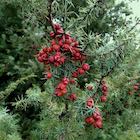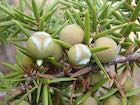Juniperus deltoides
R.P.Adams 2004
Common names
Eastern prickly juniper; بيني [Arabic]; Άρκευθος η οξύκεδρος [Greek]; ginepro rosso [Italian]; Можжеве́льник колю́чий [Russian].
Taxonomic notes
Type: Greece, 14 km e. of Archova, 420 m elevation, position 38.44533N, 22.69463E, 2001.05.22, R. P. Adams 9436 (Holotype BAYLU, Paratypes K, NY).
There are two varieties (Adams et al. 2005, Adams 2014a):
- Juniperus deltoides var. deltoides. Syn. J. oxycedrus f. parvifolia Novak 1926, J. oxycedrus var. microcarpa Neilr. 1968, J. oxycedrus var. parvifolia (Novak) Jovan. 1992, J. oxycedrus var. fastigiata Jovan. 1992.
- Juniperus deltoides var. spilinanus (Yalt et al.) Terzioglu 2010. Syn. J. oxycedrus var. spilinanus Yalt., Elicin & Terzioglu 2007.
Terpenoid and molecular data confirm that what were formerly seen as eastern Mediterranean populations of J. oxycedrus are a clearly distinct taxon within Section Juniperus, a finding confirmed by subsequent analyses including molecular work addressing all of the genus (Adams 2003, 2004, 2014a; Mao et al. 2010). This is a good example of cryptic speciation; the two taxa are separated by morphological differences too subtle to warrant taxonomic recognition, but molecular analysis has shown them to be clearly distinct, with molecular clock analysis suggesting a common ancestor about 10 million years ago (Adams et al. 2005, Mao et al. 2010). In the analysis of Adams (2014a), J. deltoides shares a clade with the Portuguese taxa J. brevifolia and J. navicularis.
Description
Evergreen dioecious shrub or tree to 12 m tall, often with a pyramidal crown of erect branches. Bark cinnamon to brown, exfoliating in thin plates. Leaves needle-like, 9-17 × 1.5-2.4 mm, tapering only in the distal portion, bearing 2 glaucous stomatal bands on the adaxial surface; adaxial surface is broad-concave. Pollen cones fertile in late spring. Seed cone ripening in 2nd year, globose, green ripening to dark red, containing 3-5 seeds (Adams 2004, 2014a).
J. oxycedrus differs in having a narrow leaf base, while the J. deltoides leaf base only tapers in the distal portion. Also, the stomatal bands in J. oxycedrus are sunken, so that the midrib is raised (Adams 2004). Also, the cone scales are visible on seed cones of J. deltoides, the tips of the cone scales generally protrude, and they usually have a glaucous bloom (visible in photos at right). Seed cones of J. oxycedrus are smooth and the cone scales are not visible on the sides of the seed cones (Adams 2014b).
Var. spilinanus is distinguished only by having a consistent shrub habit, mostly 0.4-0.6 m tall (Adams 2014b).
Distribution and Ecology
Albania, Azerbaijan, Bosnia and Herzegovina, Bulgaria, Croatia, Cyprus, Georgia, Greece, Iran, Iraq, Israel, Italy, Jordan Lebanon, Montenegro, North Macedonia, Palestine, Russia, Slovenia, Syria, Turkey, Ukraine (Adams et al. 2015, iNaturalist, accessed 2022.12.21). Based on this distribution, climate is mainly semiarid, warm-temperate and summer-dry. Habitat is not detailed but should be identical to that described for J. oxycedrus within these countries, which emphasizes development on all lithogies (siliceous, carbonate, serpentine, sometimes sand dunes) in Mediterranean sclerophyll forests (maquis, garrigue), dry woodlands, dry stony slopes especially in overgrazed areas, and occasionally wetter montane forests with conifers such as Cedrus libani and Pinus nigra. Var. spilinanus occurs in Turkey, in forest clearings at 800-1400 m elevation among Pinus brutia and P. nigra subsp. pallasiana (Farjon 2010).
The IUCN does not recognize this species and has not performed a conservation assessment. However, based on its very wide geographic distribution and correspondingly large area of occupancy, it would likely be assessed as "least concern."
Remarkable Specimens
No data as of 2023.03.03.
Ethnobotany
In Turkey an essential oil, "oil of cade", is extracted from the foliage for medicinal use (cade is a common name for J. oxycedrus in France) (Farjon 2010).
Observations
See the collection records on iNaturalist.
Remarks
The epithet refers to the tapering shape of the leaves (Adams 2004).
Citations
Adams, R.P. 2004. Juniperus deltoides, a new species, and nomenclatural notes on Juniperus polycarpos and J. turcomanica (Cupressaceae). Phytologia 86(2):49–53.
Adams, Robert P. 2014a. Junipers of the World: The Genus Juniperus, fourth edition. Bloomington, IN: Trafford Publishing. 415 pp.
Adams, Robert P. 2014b. Morphological comparison and key to J. deltoides and J. oxycedrus. Phytologia 96(2): 58–62.
Adams, R. P., Morris, J. A., Pandey, R. N., and Schwarzbach, A. E. 2005. Cryptic speciation between Juniperus deltoides and Juniperus oxycedrus (Cupressaceae) in the Mediterranean. Biochemical Systematics and Ecology 33(8):771–787. doi:10.1016/j.bse.2005.01.001.
Adams, R. P., Farzaliyev, V., Gucel, S., Leschner, H. V., Mataraci, T., Tashev, A. N., and Schwarzbach, A. E. 2015. nrDNA and petN-psbM sequencing reveals putative Juniperus oxycedrus L. from Azerbaijan, Bulgaria, Cyprus and Israel to be J. deltoides. Phytologia 97(4):286–290.
See also
Adams, R. P., and T. Mataraci. 2011. Taxonomy of Juniperus deltoides forma yaltirikiana in Turkey: leaf terpenoids and SNPS from nrDNA and petN. Phytologia 93(3):293-303.



